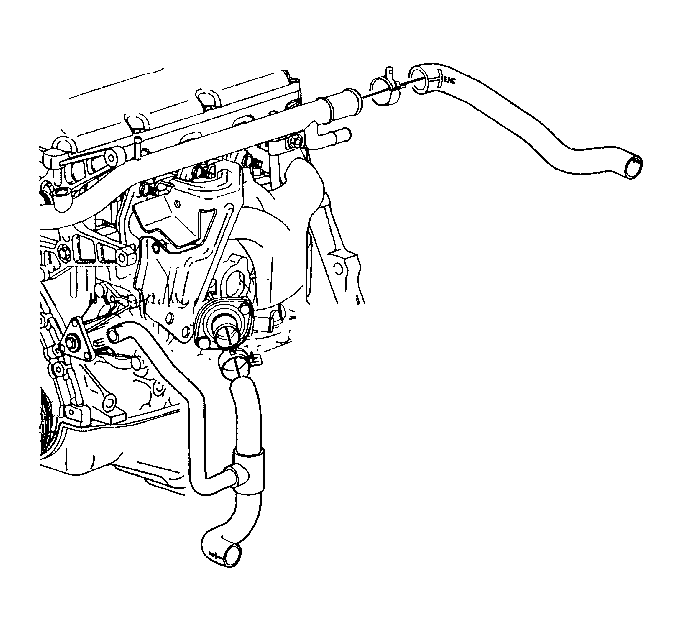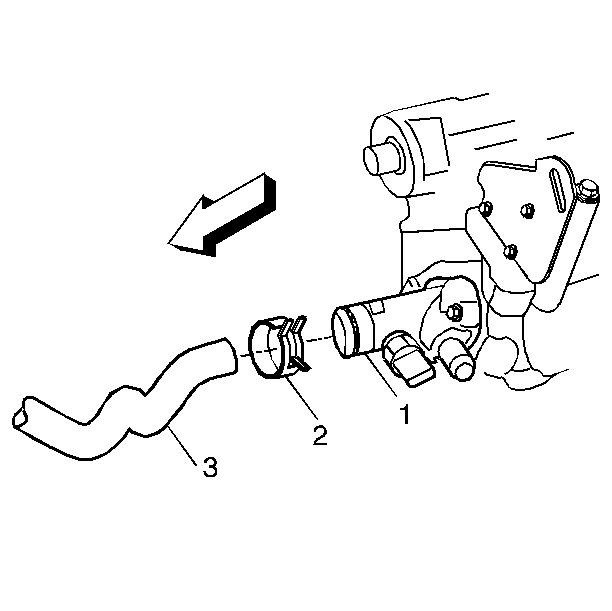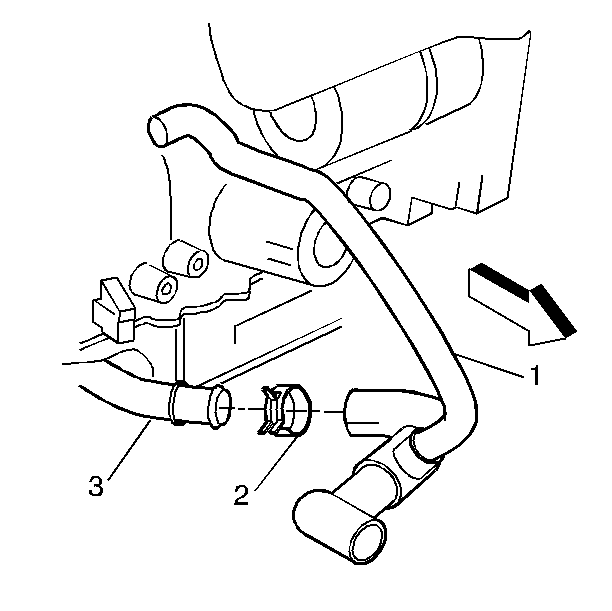Radiator Hose Replacement 2.2L
Removal Procedure
Notice: When adding coolant, use DEX-COOL® coolant. If silicated coolant
is added to the system, premature engine, heater core or radiator corrosion
may result. In addition, the engine coolant will require change sooner-at
50 000 km (30,000 mi) or 24 months.
Caution: Unless directed otherwise, the ignition and start switch must be in the OFF or LOCK position, and all electrical loads must be OFF before servicing
any electrical component. Disconnect the negative battery cable to prevent an electrical spark should a tool or equipment come in contact with an exposed electrical terminal. Failure to follow these precautions may result in personal injury and/or damage to
the vehicle or its components.
- Disconnect
the negative battery cable..
- Drain the coolant to a level below the hose being removed. Recover
the coolant. Refer to Draining and Filling Cooling System.

- Remove the radiator inlet hose and the clamps
from the radiator and the coolant outlet.
- Disconnect the radiator outlet hose and the clamps from the following
places:
| • | The radiator surge tank |
- Remove the radiator outlet hose.
Installation Procedure
Notice: Make sure the reference marks on the hoses and the radiator are lined
up. A twist on the hose would place strain on the radiator fitting which could
cause the fitting to crack or break.

- Install the radiator outlet hose and the clamps
to the following places:
| • | The radiator surge tank |
- Install the radiator inlet hose and the clamp to the radiator
and the coolant outlet.
- Connect the negative battery cable.
Tighten
Tighten the negative battery cable bolt to 15 N·m (11 lb ft).
Notice: Use the correct fastener in the correct location. Replacement fasteners
must be the correct part number for that application. Fasteners requiring
replacement or fasteners requiring the use of thread locking compound or sealant
are identified in the service procedure. Do not use paints, lubricants, or
corrosion inhibitors on fasteners or fastener joint surfaces unless specified.
These coatings affect fastener torque and joint clamping force and may damage
the fastener. Use the correct tightening sequence and specifications when
installing fasteners in order to avoid damage to parts and systems.
- Refill the coolant. Refer to Draining and Filling Cooling System.
- Start the engine. After the engine reaches normal operating temperature,
check for coolant leaks.
Radiator Hose Replacement 2.4 L
Removal Procedure
Caution: Unless directed otherwise, the ignition and start switch must be in the OFF or LOCK position, and all electrical loads must be OFF before servicing
any electrical component. Disconnect the negative battery cable to prevent an electrical spark should a tool or equipment come in contact with an exposed electrical terminal. Failure to follow these precautions may result in personal injury and/or damage to
the vehicle or its components.
Notice: When adding coolant, use DEX-COOL® coolant. If silicated coolant
is added to the system, premature engine, heater core or radiator corrosion
may result. In addition, the engine coolant will require change sooner-at
50 000 km (30,000 mi) or 24 months.
- Disconnect the negative battery cable.
- Drain the coolant to a level below the hose that is being removed.
Recover the coolant. Refer to
Cooling System Draining and Filling
.

- Remove the radiator inlet
hose (3) and the clamps (2) from the radiator and the coolant outlet (1).

- Disconnect the radiator
outlet hose (1) and the clamps (2) from the following places:
| • | The radiator outlet pipe (3) |
| • | The radiator surge tank |
- Remove the radiator outlet hose.
Installation Procedure
Notice: Make sure the reference marks on the hoses and the radiator are lined
up. A twist on the hose would place strain on the radiator fitting which could
cause the fitting to crack or break.

- Install the radiator outlet
hose (3) and the clamps (2) to the following places:
| • | The radiator outlet pipe (3) |
| • | The radiator surge tank |

- Install the radiator inlet
hose (3) and the clamps (2) to the coolant outlet (1) and the radiator.
Notice: Use the correct fastener in the correct location. Replacement fasteners
must be the correct part number for that application. Fasteners requiring
replacement or fasteners requiring the use of thread locking compound or sealant
are identified in the service procedure. Do not use paints, lubricants, or
corrosion inhibitors on fasteners or fastener joint surfaces unless specified.
These coatings affect fastener torque and joint clamping force and may damage
the fastener. Use the correct tightening sequence and specifications when
installing fasteners in order to avoid damage to parts and systems.
- Connect the negative
battery cable.
Tighten
Tighten the negative battery cable bolt to 15 N·m (11 lb ft).
- Refill the coolant. Refer to
Cooling System Draining and Filling
.
- Start the engine. After the engine reaches normal operating temperature,
check for coolant leaks.






